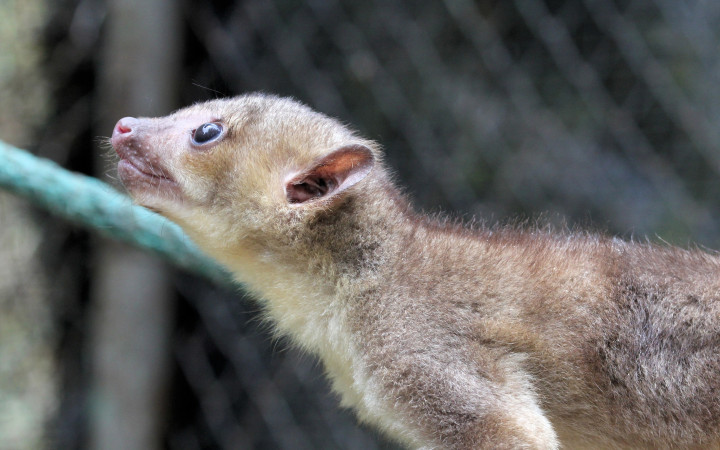Today’s Wonder of the Day was inspired by Isaiah from Sydney. Isaiah Wonders, “What is a kinkajou?” Thanks for WONDERing with us, Isaiah!
Here in Wonderopolis, we sure enjoy learning about cute animals. We’ve read all about the dumbo octopus. We’ve investigated the red panda and gone in search of white tigers. But today’s Wonder of the Day may be cute enough to rival them all. Today, we’re learning about the kinkajou!
Where can you find a kinkajou? They’re common in major zoos. But if you’d like to visit these animals in the wild, head for Central and South America. Kinkajous live in rainforests from southern Mexico to Brazil.
Kinkajous are also called honey bears. Can you guess why? If you’re thinking they must like honey, you’re right! In fact, kinkajous love honey. They’re known to use their long, thin tongues to swipe honey straight from a beehive!
The kinkajou’s tongue can grow up to five inches (13 cm) long. That makes it useful for not only swiping honey but also for taking nectar from flowers. Honey, nectar, and fruit make up most of a kinkajou’s diet. However, experts actually classify these animals as carnivores. That’s because they have canine teeth and sometimes eat eggs, insects, and small vertebrates.
Based on the name “honey bear,” you might expect the kinkajou to resemble a bear. But that’s not the case. They’re only about 16 to 30 inches (42-76cm) long. Of course, their tails nearly double their total length. Kinkajous are also light, weighing between three and ten pounds (1.4 to 4.5 kg).
A kinkajou’s tail may be its most defining feature. It’s prehensile, meaning the kinkajou uses it to grasp objects. They use their tails to climb and swing from tree limbs. Sometimes, the tail functions as a fifth hand, helping the kinkajou to balance and grab food.
Based on this description, many would think the kinkajou must be related to monkeys. But they’re more closely connected to raccoons and ringtails. Like these animals, kinkajous are also nocturnal, hunting for their prey at night.
During the day, kinkajous sleep, hidden in dark parts of the rainforest. This keeps them safe from predators like jaguars and eagles. When surprised by a predator, their unique feet come in handy. Kinkajous can rotate their feet 180 degrees. This lets them run backward as quickly as they can run forward.
What does a kinkajou family look like? Sometimes, these animals live alone. However, they can also be found in small groups. In particular, kinkajou babies stay with their mothers for up to two years.
In recent years, kinkajous have also become a popular choice for an exotic pet. While they do well in zoos and are gentle if domesticated early, most kinkajous belong in the wild. As with all exotic pets, people should think twice and check local laws before bringing a kinkajou into their homes.
Have you ever seen a kinkajou? Would you like to spot one at the zoo or in the wild one day? Maybe, if you’re lucky, you’ll even catch sight of one dangling from a tree branch in a rainforest! They’re certainly one of the cutest animals we’ve learned about in Wonderopolis lately.
Standards: NGSS.LS1.A, NGSS.LS1.B, NGSS.LS1.C, CCRA.R.4, CCRA.L.3, CCRA.L.6, CCRA.R.1, CCRA.R.2, CCRA.SL.1, CCRA.R.10, CCRA.W.2, CCRA.W.9, CCRA.L.1, CCRA.L.2




